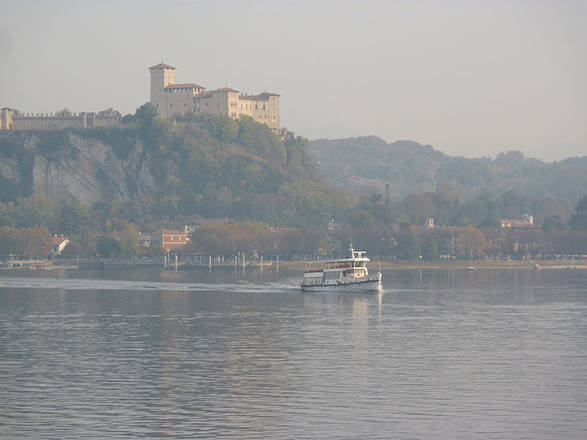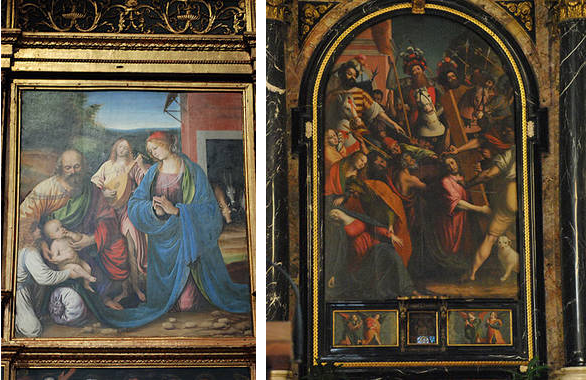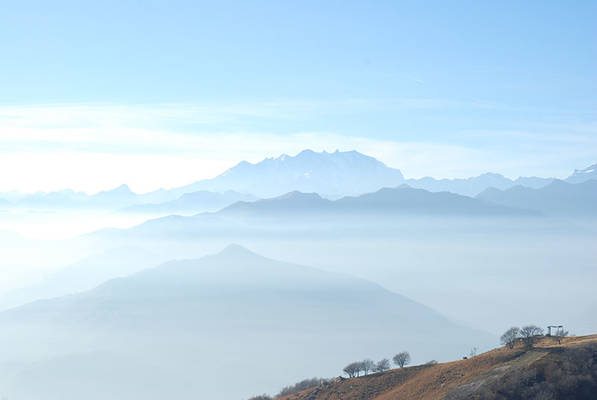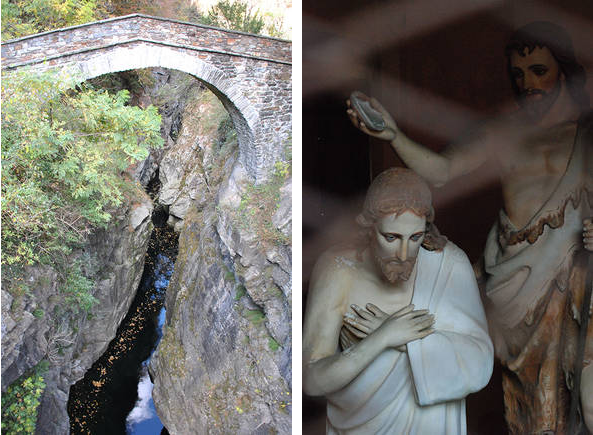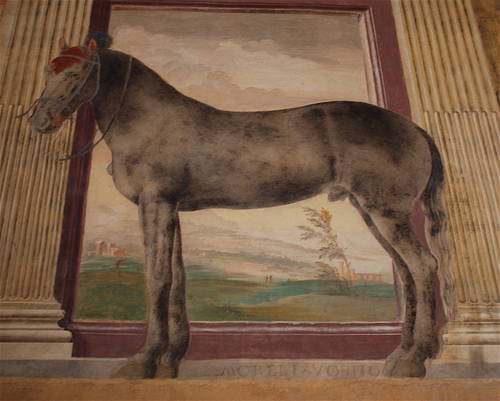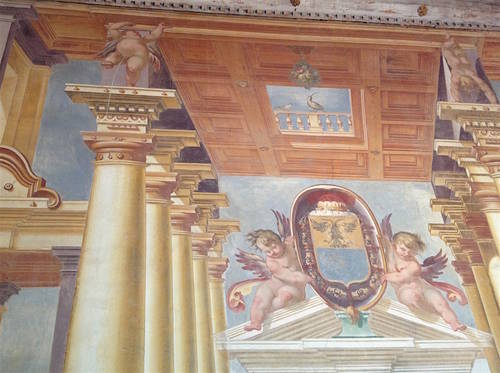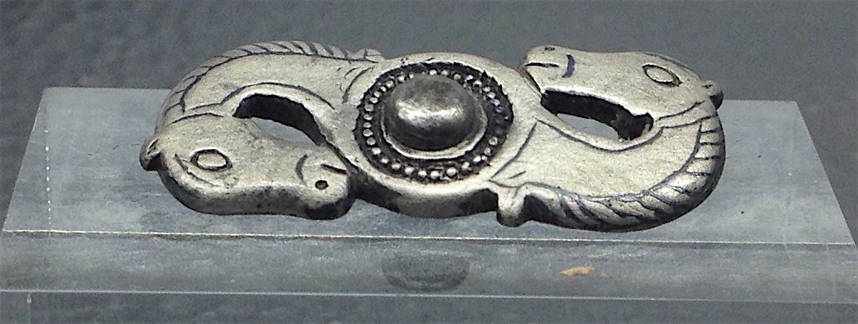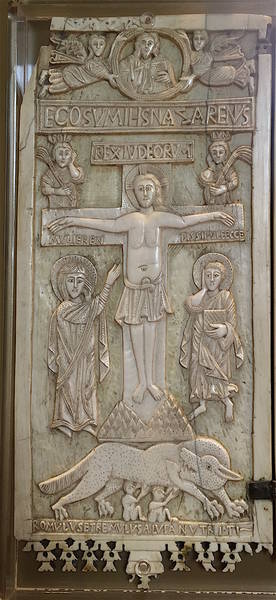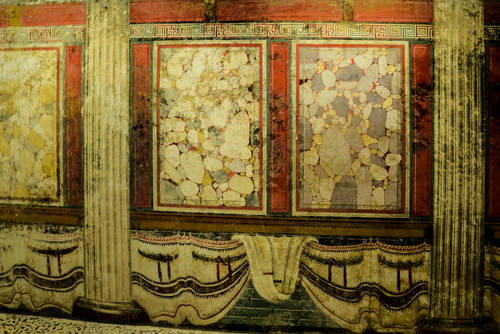A major exhibition is in progress (until 24 June) in the Palazzo Reale in Milan: Dürer and the Renaissance (between Germany and Italy). One wonders if the title was chosen rather to entice visitors than to explain the true content of the show: ‘Dürer’ without ‘the Renaissance’ may have been a good deal less of a draw. But in fact the works on show display above all the extraordinary artistic powers of Dürer, not only as an engraver and woodcutter but also as a draughtsman and painter in oil and watercolour. The works by his contemporaries, displayed alongside, are often put into the shade by the great German’s skills. The choice of these works is not always particularly logical. But (again, perhaps to be sure to draw the crowds?) the visitor is given a very special opportunity to see Leonardo da Vinci’s unforgettable St Jerome, lent by the Vatican Pinacoteca, as well as two of his drawings from Windsor.
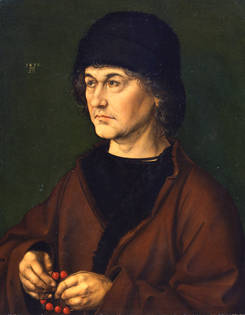
a portrait of his father.
The first two paintings on show are both by Dürer and both from the Uffizi: the Adoration of the Magi and a portrait of his father, his first known painting. In the same room is a drawing of a Battle of Marine Gods, divided into two parts since Dürer added a scene to an earlier representation of the same subject by Mantegna, a clear indication of the close relationship between these two artists and a demonstration of how Dürer studied the technique of the most skilled Italian engraver at work in his lifetime. These two sheets are here brought together, the first from the Albertina in Vienna and the latter from the Rijksprentenkabinet in Amsterdam.
One wall of this first room has a series of studies of horses, showing some of the very earliest known drawings by Dürer as well as his celebrated engraving of The Knight, Death, and the Devil, dated 1513 (this, like most of Dürer’s most beautiful engravings in the exhibition, comes from the Schȁfer Collection in Schweinfurt).
The exhibition also documents Dürer as a theorist, with his treatises on proportion and measurement and his clear fascination with Leonardo’s studies. A drawing in red chalk by Leonardo (one of the two on loan from Windsor) is a reminder of the famous artist’s sojourn in Milan: it is a view of the Alps as seen from the city (today, on a clear day from the roof of the Duomo, the mountains are still just as visible).
One of the most intriguing protagonists of the exhibition is Jacopo de’ Barbari, whose bird’s eye view of Venice in the year 1500, printed by the German Anton Kolb at his shop on the Rialto from six wood blocks, has been lent by the Correr Museum (it is a pity they didn’t also send the six original blocks carved by De’ Barbari which, incredibly enough, have survived). It is interesting to note that this woodcut was, in the past, attributed to Dürer himself, since little was known about De’ Barbari, and his dates are still uncertain. He almost certainly met Dürer in Venice and he is also recorded as having visited Nuremberg, Dürer’s native city. One of the few other works known by him is also on display: a very fine engraving of Pegasus (on loan from Amsterdam). Both De’ Barbari and Dürer are recorded as having worked for Maximilian I. Indeed, the Habsburg emperor was Dürer’s most important patron and the huge triumphal arch he designed for him (in a series of no less than 192 woodcuts), with allegorical and historical scenes, is also on display (recomposed from the 36 surviving original blocks and supplemented with photographic reproductions of the missing ones). Maximilian died in 1519, so that another commission to produce a triumphal procession to celebrate the ruler, some 50m long (made up of 192 blocks, eight of which are on display) was interrupted: this was perhaps a blessing for posterity since it meant that Dürer could turn to other works and other media. On the wall close by, an exquisite small drawing of a procession (from Berlin) demonstrates how he could also work on a much smaller scale: ‘As I grew older, I realised that it was much better to insist on the genuine forms of nature, for simplicity is the greatest adornment of art.’
Another famous Venetian, Giorgione, whose influence on Dürer has long been recognised, is represented with his remarkable Old Woman (from the Gallerie dell’Accademia in Venice). On Dürer’s two visits to Italy (in 1505–7; and earlier in 1494, though that visit is undocumented) he also came into contact with Giovanni Bellini and was particularly inspired by his portraits. In Dürer’s letters he writes of the great Venetian painter, now in old age, whom he felt was the only Italian who seemed to appreciate his artistic skills. He also boasts that when his Madonna del Rosario was completed for the church of San Bartolomeo at the Rialto, which served the German community in the city, both the Doge and the Patriarch came to see it. (When the church was renovated in 1610, the altarpiece was sold and is now in the National Gallery of Prague: it is sadly only represented in this exhibition by a copy—albeit a good one—made around the time it left Italy.)
The work chosen to represent the exhibition (and used on the cover of the catalogue) is Dürer’s Portrait of a Young Venetian Woman, a small oil painting known to have been made during his stay in Venice in 1505 (lent by the Kunsthistorisches Museum in Vienna). It is exhibited next to his beautiful large Portrait of a Peasant Woman (with a bashful smile), in charcoal and green wash, drawn in the same year (the notable creases may indicate that it was made on the artist’s way to Italy so that he had folded it up during the journey). Another portrait, of a young woman with a jewel hanging from her red beret, painted two years later, is just as beautiful, but it could be argued that these three works have little to do with Venetian portraiture except in their format. A small group of portraits painted against striking green backgrounds perhaps demonstrate a reciprocal influence (particularly the portrait of a young man in a black hat by the Bergamo painter Andrea Previtali and that of a similar subject by Dürer, both painted in Venice in 1506). The best work in this group, though, a portrait of a woman by Lorenzo Lotto, is far distant in atmosphere from Northern European portraiture.
Bizarre elements in Dürer’s oeuvre include engravings of a chained monkey depicted beside a Virgin and Child, and a faun in an idyllic setting with his (human) wife and child. His skill in watercolour is demonstrated by images of a huge crab and a duck (hanging by its beak).
The curators have been careful to keep strictly to the short period in which Dürer made his two presumed visits to Italy and this adds greatly to the interest of the exhibition. Much magnificent art was produced in these few years from 1490 to 1510, by Dürer and his contemporaries, and examples have been gathered together here from many different parts of Europe. It is doubtful that we will see again for many years so many outstanding examples of Dürer’s work in one place. An occasion not to be missed, especially as a visit provides the added advantage of its venue: Palazzo Reale in Piazza Duomo in Milan.
By Alta Macadam. Alta has just returned from a research trip to Milan for the forthcoming Blue Guide Lombardy, Milan and the Italian Lakes. She found the city vibrant and a wonderful place to visit, with much in progress on the contemporary front, new urban areas with innovative architecture, many museums opened in the last few years, and the historic ones (notably the Brera) keeping up with fresh ideas on display to increase the enjoyment of a visit. The new Blue Guide is due out at the end of 2018.







